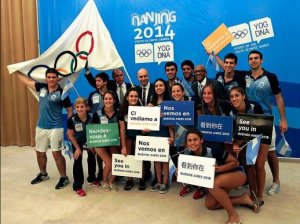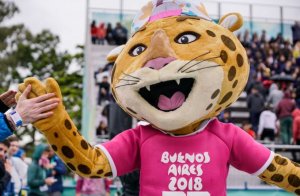Have You Heard Of The Youth Olympic Games?

The visionary of one of the most important sporting events in modern history is the Austrian, Johann Rosenzopf. A former industrial engineer, concerned about the alarming statistics regarding worldwide childhood obesity. That’s how, just a couple of decades ago, he invented what would later become, the Youth Olympic Games.
Initially, the International Olympic Committee (IOC) didn’t want to create new multi-sport events. The leaders of the world sports federation were afraid of overloading the competition calendar. Furthermore, the economic risk that an event with such characteristics posed really concerned them.
But finally, on July 5th, 2007, Rosenzopf’s struggle paid off. During the 119th IOC Assembly, his idea was given the green light. However, the assembly didn’t recognize him as the creator of the games until 2010.

Singapore 2010: first youth Olympic games
The first version, officially named The First Youth Olympic Games, was held from August 14th to 26th, 2010. Around 3,600 athletes aged between 14 and 18 years competed in 204 events of 26 sporting categories.
The event was not exempt from some polemic, but in general, people considered it to be a worldwide success. The Japanese triathlete Yuka Sato aged 18 years, won the first gold medal of the competition.
China, with a total of 51 medals (30 gold, 16 silver, and five bronze) finished in the highest position. Russia and South Korea completed the podium. The Spanish delegation was in the 33rd spot of the general classification, winning one gold medal, four silver, and six bronze.
But throughout the thirteen days that this sporting event lasted for, not everything was about competition. Young people from all corners of the globe had the opportunity to discuss important topics such as health, education, and equality.
Nanjing 2014
The second Youth Olympic Games took place in Nanjing, located in the east of China. This was one of the cities where young athletes from 204 different countries reunited from August 16th to 28th, 2014.
China held the highest position on the medal table, winning 36 gold medals, 13 silver, and 14 bronze. Russia also kept its second place, while the United States took the last place in the podium.
The Spanish representatives stayed in the same position as the first event, winning two gold medals, one silver and six bronze. It was a really decent participation.
Along with the sporting events, this cultural program had a specific goal during the games. One of the objectives of the organizing committee was to promote a healthy lifestyle for young people through the Olympic values.
Buenos Aires 2018: first games out of Asia
In 2013, the IOC selected this South American city for the third version of the Youth Olympic Games. They chose Argentina’s capital above Medellin (Colombia) and Glasgow (Scotland). These other two cities stayed as candidates until the final voting.

On this occasion, 4,012 athletes were convened from 206 nations out of the five continents. Eight disciplines debuted in the official program. They were: karate, climbing, breaking, inline speed skating and BMX freestyle.
Olympic games without official medals
For many people, knowing how many medals each country wins is part of the attractiveness of these types of sporting events. However, the organizing committee has been trying to avoid the curiosity that people usually have about winning.
They insist that the main purpose is to integrate young people from around the world. The mere fact that an athlete participates should be a success by itself. Way more important than the medals each country wins.
Pandi, the official mascot
Mascots can’t be missing in any worldwide sporting competition. The one for Buenos Aires 2018 was Pandi, a young-looking yaguarate, a type of jaguar that lives in North Argentina and is and an endangered specie.
The goal of this mascot is similar to the goal of other mascots in different sporting competitions: inspire young people about the transforming power of sports.
The next date: Dakar 2022
The International Olympics Committee decided to give more protagonism to Africa; so, the IV Youth Olympic Games has a confirmed a host for 2022. Dakar, the capital of Senegal will be in charge of receiving all the new young athletes from all around the world.
The visionary of one of the most important sporting events in modern history is the Austrian, Johann Rosenzopf. A former industrial engineer, concerned about the alarming statistics regarding worldwide childhood obesity. That’s how, just a couple of decades ago, he invented what would later become, the Youth Olympic Games.
Initially, the International Olympic Committee (IOC) didn’t want to create new multi-sport events. The leaders of the world sports federation were afraid of overloading the competition calendar. Furthermore, the economic risk that an event with such characteristics posed really concerned them.
But finally, on July 5th, 2007, Rosenzopf’s struggle paid off. During the 119th IOC Assembly, his idea was given the green light. However, the assembly didn’t recognize him as the creator of the games until 2010.

Singapore 2010: first youth Olympic games
The first version, officially named The First Youth Olympic Games, was held from August 14th to 26th, 2010. Around 3,600 athletes aged between 14 and 18 years competed in 204 events of 26 sporting categories.
The event was not exempt from some polemic, but in general, people considered it to be a worldwide success. The Japanese triathlete Yuka Sato aged 18 years, won the first gold medal of the competition.
China, with a total of 51 medals (30 gold, 16 silver, and five bronze) finished in the highest position. Russia and South Korea completed the podium. The Spanish delegation was in the 33rd spot of the general classification, winning one gold medal, four silver, and six bronze.
But throughout the thirteen days that this sporting event lasted for, not everything was about competition. Young people from all corners of the globe had the opportunity to discuss important topics such as health, education, and equality.
Nanjing 2014
The second Youth Olympic Games took place in Nanjing, located in the east of China. This was one of the cities where young athletes from 204 different countries reunited from August 16th to 28th, 2014.
China held the highest position on the medal table, winning 36 gold medals, 13 silver, and 14 bronze. Russia also kept its second place, while the United States took the last place in the podium.
The Spanish representatives stayed in the same position as the first event, winning two gold medals, one silver and six bronze. It was a really decent participation.
Along with the sporting events, this cultural program had a specific goal during the games. One of the objectives of the organizing committee was to promote a healthy lifestyle for young people through the Olympic values.
Buenos Aires 2018: first games out of Asia
In 2013, the IOC selected this South American city for the third version of the Youth Olympic Games. They chose Argentina’s capital above Medellin (Colombia) and Glasgow (Scotland). These other two cities stayed as candidates until the final voting.

On this occasion, 4,012 athletes were convened from 206 nations out of the five continents. Eight disciplines debuted in the official program. They were: karate, climbing, breaking, inline speed skating and BMX freestyle.
Olympic games without official medals
For many people, knowing how many medals each country wins is part of the attractiveness of these types of sporting events. However, the organizing committee has been trying to avoid the curiosity that people usually have about winning.
They insist that the main purpose is to integrate young people from around the world. The mere fact that an athlete participates should be a success by itself. Way more important than the medals each country wins.
Pandi, the official mascot
Mascots can’t be missing in any worldwide sporting competition. The one for Buenos Aires 2018 was Pandi, a young-looking yaguarate, a type of jaguar that lives in North Argentina and is and an endangered specie.
The goal of this mascot is similar to the goal of other mascots in different sporting competitions: inspire young people about the transforming power of sports.
The next date: Dakar 2022
The International Olympics Committee decided to give more protagonism to Africa; so, the IV Youth Olympic Games has a confirmed a host for 2022. Dakar, the capital of Senegal will be in charge of receiving all the new young athletes from all around the world.
This text is provided for informational purposes only and does not replace consultation with a professional. If in doubt, consult your specialist.








